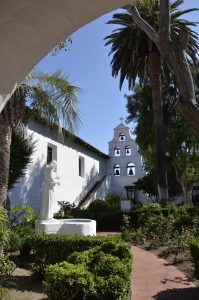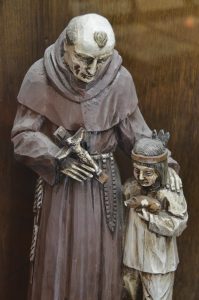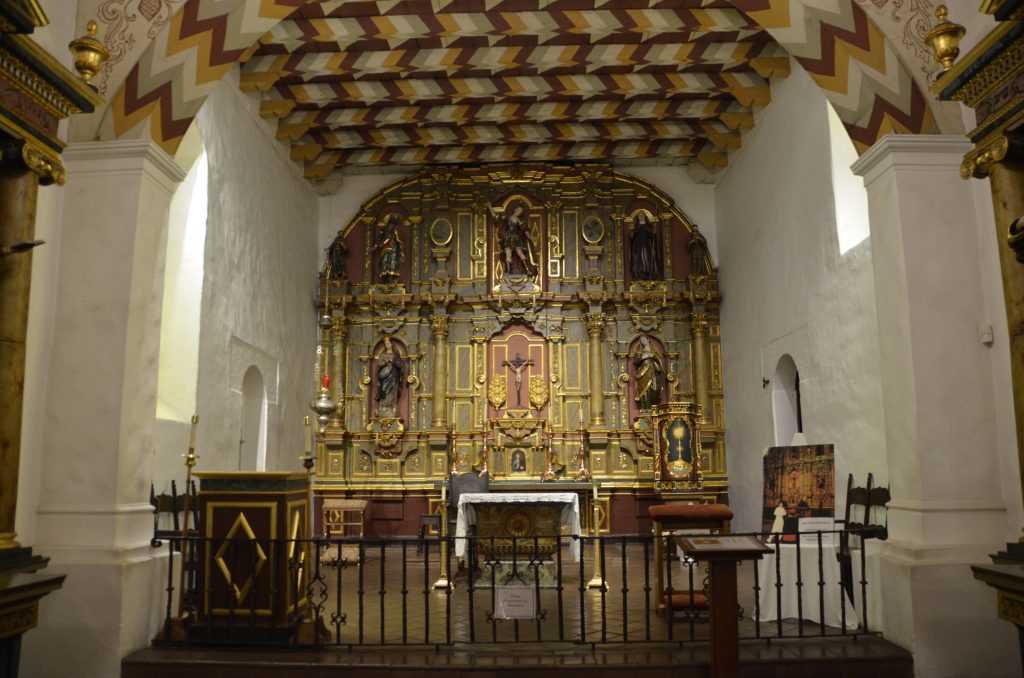At the heart of pilgrimage is a longing that has fascinated and compelled the human spirit from time immemorial. And this ancient practice is experiencing a growing attraction and taking on new forms today. In fact, America now has its own pilgrim way: the road connecting the California missions of St. Junípero Serra, canonized in 2015.
In ancient times, pilgrimage often involved distant travel along hazardous roads and across perilous seas. Today, Christians continue to make long journeys along ancient pilgrimage routes — the path of Jesus through Galilee to Jerusalem, the way of the early martyrs in Rome, and the Camino of Santiago de Compostela — seeking the transforming power that seems to reside in these sacred places.
But such distant travel is not necessary to experience a pilgrimage. More and more people are discovering that a journey in the way of America’s great missionary saint, the apostle of California, is a superb way of absorbing his saintly passion and love for the Gospel. Travelers today, like pilgrims of old, are experiencing a transforming journey along the Camino — the pilgrim way.
St. Junípero’s motto — “¡Siempre Adelante!” (“Always Forward!”) — expresses his courageous life, bringing the good news of Jesus Christ to the Native Americans of California. By traveling his Camino with a pilgrim’s heart, we can prepare ourselves to continue, in our own way, the journey forward that he began in California from 1769 to his death in 1784. By embodying his spirit on pilgrimage, we can become more missionary in our discipleship and more evangelical in our Catholicism.

Traveling the Camino
The missions — 21 in number, beginning in San Diego and stretching to Sonoma, north of San Francisco Bay — were the inspiration of St. Junípero. As he envisioned them, the missions would form a holy ladder, with rungs placed conveniently up and down the coast. This “royal way” — El Camino Real — holds the tangible memories of the days when Christianity first came to California.
St. Junípero’s Camino links these missions as a pilgrimage route. Begun as trails created by the California Native Americans for travel and trade, this roadway was adopted by the Spaniards as they explored and settled California. Today, while much of it lies under the asphalt of Highway 101, in other areas it can be traced along city streets, rural roads, and still occasionally as dirt trails on mission grounds.
Nowadays, this Camino is most conveniently traveled by car along the California coastal highways. The route is marked by a series of miniature mission bells originally erected in the early 20th century. These cast-iron bells have been hung from 11-foot bent guideposts, designed to resemble a shepherd’s staff and to be easily visible along the route. Travelers simply follow a map or set their GPS device to move from one mission to the next.
Each of the 21 missions is a unique jewel and a spiritual oasis. The sacrifices of the indigenous peoples who built these places and memories of the early missionaries and their ardor for the Gospel pervade these grounds.
The walls and ceilings of the mission structures express the Native American culture, with bright oranges, reds, yellows, and blues in geometric patterns. Iridescent abalone shells, spiritually powerful objects for the Indians, hold holy water in wall niches and adorn the tabernacle for the Eucharist. Old Spanish mission art can be found next to Indian wall paintings, as symbols of piety from two centuries ago form a wonderful, holy mix.
Some of these missions are found wedged into cities; others are surrounded by mountains and valleys. They have all been shaped and reshaped for generations. The grounds are filled with bells, statues, fountains, and gardens, all symbols of life and feasts of color. Native American talents blended with European ways to create thriving communities.
Yet those who travel along this ancient road not only experience slices of history, but also gain opportunities to encounter the presence of the living God in tangible ways today. All but two of the missions are functioning churches, where Christian baptisms, holy Mass, and beautiful weddings are regularly celebrated.
The Sunday schedule of worship alternates between English and Spanish and sometimes includes services in Vietnamese, Haitian, Portuguese, and other languages for California’s immigrant communities.
St. Junípero’s Camino is the ideal pilgrimage. It challenges the traveler to make an internal, spiritual journey that parallels the external, geographical trip. In traveling this road, pilgrims encounter holy places, communities of faith, occasions for meditative prayer, and prospects for inner healing — all opportunities to align their lives more closely with the Gospel.
The pilgrimage can be as rugged or as luxurious as you choose. My first trip through the missions was in a rental car, driving along the coast at my own pace, stopping to seek lodging at the end of each day. I’ve also led pilgrimages in luxury coaches, with nice hotels and dinners awaiting us each evening. And I’ve always admired hikers and cyclists trekking to one mission after another, as in the days before gasoline and electric power.
The missions as spaces for encounter
Far more than museums documenting the past, the missions have always been places of encounter among peoples. They began as Native American and European cultures met. Two traditions wove themselves together: the Spanish Franciscan way — which affirmed the goodness of creation and the incarnation of God in the world — and the California Indian spirituality — which practiced respect for the earth and the divine spirit that fills it.
St. Junípero was part of a missionary team that went out to the peripheries — beyond the geographical, social, and racial boundaries of their time — to proclaim the Gospel. Yet in his encounter with the Native American people, he sought to understand their indigenous spiritual beliefs.
His diaries show examples of how he used traditional beliefs as springboards for preaching the Gospel. He fiercely criticized the Spanish colonists and military, consistently protecting the Native American people from being mistreated or morally tainted. He poured out his life out of love for the California Indians, and they deeply loved him in return. Six-hundred wept at his funeral, piling his bier high with wildflowers, and countless people testified to his sanctity.
At St. Junípero’s canonization, Pope Francis said that he embodies a Church that goes forth: “He was excited about blazing trails, going forth to meet many people, learning and valuing their particular customs and ways of life. He learned how to bring to birth and nurture God’s life in the faces of everyone he met; he made them his brothers and sisters.”
Following St. Junípero’s Camino convinces us that all of the baptized have two fundamental callings: the calls to holiness and to mission. In the extraordinary life of St. Junípero, holiness and mission were one, unified in the joy of the Gospel.

As pilgrims in his way, we take on his joyful conviction, learning to leave behind our islands of comfort and witness to Jesus Christ in the modern world. And because of our call to holiness, we proclaim his good news not only with words, but above all by a transfigured life.
Pope Francis said that this call to evangelize must be a normal part of a mature, authentic, and integrated Christian life. Evangelization is the urgent call of our Church: to renew, expand, and cultivate disciples. St. Junípero’s Camino points the way forward for us. “The joy of the Gospel,” the pope said, “is something to be experienced, something to be known and lived only through giving it away, through giving ourselves away.”
The response of St. Junípero and his followers to the call to share the Gospel is a complex reflection of who we are and have always been as a Church: a sinful yet holy people, constantly striving to follow God’s will as best we can in light of our weaknesses and our strengths, with both our blindness and our zeal to be missionary disciples of Jesus Christ.
From our perspective today, we can see that the early missionaries of California were often too immersed in their own European culture to clearly see the richness of the culture they were entering. In their eyes, European culture was “civilized,” while the Native American culture was “primitive.” As global Christians today, we have to learn to see how the Gospel lives in a multitude of cultural contexts, obliging us to be humble in examining beliefs and customs in order to bring Jesus Christ to another culture.
Today, Christian Native Americans in California seek ways of being equal participants in the life and mission of the Church — as indigenous people. They continue to explore ways to experience the freedom and spiritual power of the Gospel, while still fully embracing their tribal identity, traditional customs, and cultural ways in their expressions of faith in Jesus Christ.
As we embrace a multicultural Church, as it exists today in California and in our own local context, let us celebrate our universal Christian faith, expressed through the languages, customs, art, music, values, and rituals of Native American, Spanish, Mexican, and a host of Asian, African, and European cultures. By doing so, we continue to follow the Camino of St. Junípero.
A pilgrimage worth taking
Traveling along St. Junípero’s Camino and enjoying the beautiful California missions, let us work for healing, lamenting what went wrong in the past and acknowledging the real pains that remain. But let us also recognize the heroism of St. Junípero and all the great men and women, Native American and Hispanic, who sanctified the missions of California and bear witness to their history.
Go to the mission churches with a pilgrim’s heart searching for God. Take the water of the font at each door into your hand, reminding you of baptism and the water of new life that God desires to spring up within you. Bless yourself as a tangible sign of the saving death and resurrection that unites believers in one faith. Light a candle at your favorite altars as a sign that your prayer lingers in this place after you depart.
If you arrive and the church is filled with people celebrating a Mass, baptism, wedding, or funeral, don’t turn away, disappointed that your touring has been impeded. But stand to the side, grateful that the faith these missions represent remains alive for so many today.
The questions that arise along America’s pilgrim way become the challenges of our discipleship today. Can the missionary past be transformed into something new that speaks powerfully and challenges the era in which we live? Can the sparks of sanctity still alive from missionary California come to flame today to bring about justice and reconciliation for the people of our land? The rich spirituality of pilgrimage along St. Junípero’s Camino can arouse within Christian travelers today a deep desire to hope, work, and pray for a new civilization of love.

